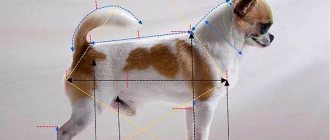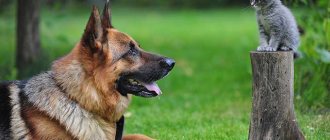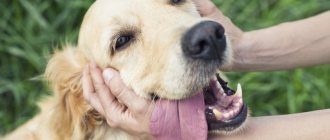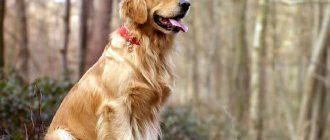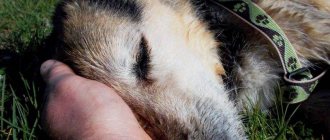The dog sleeps on its back: normal or pathological
Our pets are full-fledged individuals who have their own preferences and opinions about comfort. Do you find it strange that your dog sleeps on his back? Don't worry, this is completely normal, and there are reasons for every dog sleeping position. Observations by owners and animal psychologists made it possible to establish some relationship between sleep posture and the temperament of the ward.
Initially, the theory of sleeping positions was treated with skepticism, exactly until the moment sleep positions in humans were interpreted. You may have come across information that married couples sleep differently, which reflects the subconscious mood of the partners towards each other (trust, mistrust, mutual tenderness, etc.). A little later, psychologists came to the conclusion that sleep position depends on a person’s mood and his internal experiences.
Conclusions about human sleep positions are made based on observations of control groups. Such studies have not been conducted for dogs, but popular statistics are very close to the truth, at least according to the majority of four-legged owners.
Observations of wild dogs made it possible to understand that each sleep position has certain functions . Larger dogs sleep in relaxed positions because they are in a defensive position. Puppy bitches sleep in such a way that, if necessary, they can quickly get to their feet and protect their offspring. Male leaders sleep not deeply and with their backs to the pack, because they instinctively protect their subjects. Puppies are children, so they sleep as they please and the position is not always natural.
If your puppy sleeps on his back without obvious discomfort, it means he is comfortable . If you notice that your baby is snoring or snoring , observe his behavior while he is awake. Your task is to identify difficulty breathing during exercise or make sure that there are no problems. Puppies with short muzzles tend to snore - this is the norm.
Aggressive actions
Since we're talking about bites, let's see what superstitions say about dog aggression. For example, a dog...
Catching up
- A dog that chased you barking, but fell behind before reaching you, portends troubles and minor bad luck. Nothing life-threatening threatens you, but you will have to spend your nerves (and possibly money).
- It's a completely different matter if you come across a bitch protecting puppies, or for some reason the dog considers you a dangerous enemy. From the animal’s point of view, it had a reason to attack you, and such behavior does not promise you any negative events.
Attacks
Unreasonable dog aggression is a bad sign
- If the dog attacks aggressively, spins around and doesn’t lag behind for a long time, this sign is more serious. There is a good chance that you will soon have a meeting with robbers or an aggressive company. Don’t get into conflicts with strangers, stop walking in remote places, and try to return home long before dark. And the money will remain with you, and you will save your health.
- Sometimes a dog attack is explained as a warning of danger for a person you care about, or as a sign of failure in a planned business. Ask your loved ones to be careful, and carefully weigh all the risks before making decisions.
- Remember that dogs react very strongly to the smell of fear. They will not let go of a person who walks by with his knees buckling from horror without barking. Isn't it time for you to take courage?
Bites
Do you think that after everything that has been written, a dog bite is a completely black omen? But no!
- If a girl of marriageable age is bitten by a neighbor’s dog, it’s time for her to prepare to welcome the groom. Moreover, the betrothed will be the envy of all his friends - it’s not scary to suffer a little for this.
- If a man or woman is bitten by their dog, someone close to them will soon let them down and thus cause a lot of grief.
- If the dog is a stranger or a stray, the person who was bitten will face trouble at work. And if you are too lazy to show the bite to the doctor, then you will have health problems. And this is no longer a sign, but a reality.
By the way, here are a couple more pieces of folk wisdom on this topic:
- In order for the bite to heal without consequences, it should not be shown to strangers.
- For better healing, Japanese alternative medicine suggests sprinkling the bite site with ashes from a burnt tuft of dog hair, while Russian medicine suggests swallowing the hair and applying fresh herring to the wound. However, we would not advise you to try extravagant treatment methods on yourself. It’s easier and safer to limit yourself to official medicine.
What do sleeping positions mean in dogs?
The most common sleeping position is on the side or on the stomach. The popularity of this position is due to the instinct of self-preservation - the dog can quickly stand up and, if necessary, make a jump. Being in this position, the quadruped does not sleep deeply, but is in the REM phase of sleep (rapid eye movement sleep).
Based on the sleeping position on the hip, the dog owner can conclude that his pet is either not very tired or does not feel safe . You shouldn’t be too wary, especially if your dog has service or guard skills. Most likely, in this position your pet dozes during the day and enters the deep sleep phase at night.
Many dogs sleep on their side - this is the most relaxed position, indicating that the pet feels completely safe . A pet bed should be much larger than the dog itself only because in the most comfortable position (on its side) all muscles are relaxed and the animal is fully rested.
This is interesting! The peak of the immune system's functioning occurs during the deep phase of sleep, in which all the dog's muscles are relaxed. This means that an uncomfortable bed in which the four-legged dog is forced to curl up literally reduces the level of the pet’s immune defense.
The superhero pose is characteristic not only of puppies, but also of some dog breeds. Large quadrupeds rarely sleep in this position, since their muscles are weak and do not allow them to stretch out all their legs without discomfort. The position of a superhero is considered in two versions:
- Lying supine on your stomach, throwing back your hind and front legs.
- Lying in a similar position, but the front legs are extended along the body.
The position is more common in puppies because they are more carefree. Nevertheless, superheroes are ready to jump up at any moment and this is a reflection of the work of self-preservation instincts.
Sleeping in a ball (fox or nutshell pose) - the dog curls up, hiding its paws and throat, covering itself with its tail . The pose suggests several motives: defense and burning. Be that as it may, your pet is not very comfortable, since all the muscles of the body do not relax in this position. Perhaps your pet needs a larger bed or a quiet environment to get a good night's sleep. Although, some owners note that their dogs sleep in a ball all their lives, remain healthy and vigorous, and this only confirms the theory that all dogs are individual.
If your dog likes to sleep on his back, this indicates a feeling of puppy happiness , complete relaxation and comfort. No pet will lie down on its back unless it feels safe or trusts its owner. During the hot season, sleeping on its back allows the four-legged animal to quickly cool down and fully relax in a short period of time.
Note! According to the observations of owners, dogs that like to sleep on their backs are self-confident, balanced, fully formed (mentally) and very self-sufficient. From such pets, owners do not expect misconduct, disobedience, clashes with relatives or other strange behavior.
Another option for back sleeping is for the dog to lie down next to another pet or owner . Among dog owners, a common phrase is the “pose of complete trust,” when the dog falls on its back, influences with its tail and exposes its stomach. In the wild, not all animals can afford such luxury and the position on their back is typical only for puppies or mating partners. If your pet sleeps next to you, lying down on its back, this indicates a high degree of trust and a desire to establish a direct connection.
Carefree pose - lying on your back with your paws up. This position looks a little strange, even unnatural, but it is typical for large dogs with long limbs. The problem is that very large dogs experience natural but severe stress on their elbows, hips and chest.
At the stage of the formation of large varieties of dogs, there was no talk of selection or maintenance of weak animals; unadapted animals simply died. Our pets are surrounded by care and need additional comfort, since their lifestyle and its duration are far from natural.
Other signs
- Expect cold weather if the dog hides his nose in his fur.
- Eating snow means bad weather.
- Chews grass or climbs into the water - there will be rain.
- If the dog is stretched out on its stomach, warm weather is ahead; if it curls up in a ball, cold weather will begin. And this is not a simple observation, but a scientific fact. Animals are very sensitive to the temperature of the earth, which is why they can make accurate forecasts.
- Animals tend to be sleepy before long periods of bad weather.
Of course, not all signs have retained their meaning in our time. Some seem hopelessly outdated. Others are downright ridiculous, not to say stupid. And yet, among a dozen beliefs, no, no, and there will be one or two that hit “not in the eyebrow, but in the eye.” So it’s definitely too early to discount the age-old observations of folk wisdom.
The cutest dog sleeps on his back: the vet explained why
We talked to a veterinarian about unusual dog habits
04/03/2019 at 20:03,
A charming Shih Tzu dog is gaining popularity online. The dog is not only charming in itself, but also attracts attention with an unusual feature: he sleeps only on his back!
A little Shih Tzu named Paninin became famous thanks to a photo that his owner, Filipina Yaness Cua, accidentally posted online. The puppy slept on it in a position that was extremely unusual for a dog - stretched out on its back with its paws neatly folded at its sides. The photo of baby Paninin became so popular that Yaness began posting more and more pictures of her pet and now he has become a real hero of the Internet.
Peninin became not only a hero of social networks, but also inspired many users to create: people post their drawings and videos of their favorite hero, and some even claim that he stole their hearts.
By the way, there were also those who were seriously worried. What if the animal’s touching pose is a sign of some serious illness? We decided to reassure everyone who was worried and told veterinarian Svetlana Viktorovna about Peninin.
There is absolutely no reason for concern here,” the doctor laughs. — Dogs can sleep in a variety of positions: lounging, stretched out, on their backs, and on their stomachs. If the animal does not show any other signs of health problems, for example, impaired motor functions, disorientation, then there is no need to worry - your pet is just special. The main thing is that he is comfortable and comfortable.
So, if you notice your pet sleeping in such an atypical position, there is no need to worry - it’s better to take a photo as soon as possible. Who knows, maybe your pet will become a star?
- The most interesting
- Comments
Leave your comment
User comments
Why train an animal?
Early socialization of pets, training to carry out mandatory basic commands for dogs, given by voice or gesture, are ways to educate animals and teach them obedience. In the process of training, dogs become controllable, and the threshold of their natural aggressiveness decreases.
A little mess in the house caused by a pet
For your information! It has been proven through the bitter experience of many dog owners that even breeds that are characterized by great love for their owners can show their negative tendencies without being taught to obey.
Learning commands for dog training is necessary, first of all, for humans to ensure comfortable coexistence between owner and pet. The inability of the owner to influence the behavior of the animal can lead to the fact that even a small decorative English York Terrier can become the cause of a conflict situation during a walk. Animals also need exercise to strengthen and maintain their health. Failure of a pet to comply with the simplest dog commands very often leads to injury or even death.
Important! The owner is responsible for an attack by a pet on a stranger. The animal should not be a threat to the people around it and other animals.
German Shepherd training
Popular on social networks
© JSC "Editorial office of the newspaper "Moskovsky Komsomolets" Electronic periodical publication "MK.ru"
Registered by the Federal Service for Supervision of Communications, Information Technologies and Mass Communications (Roskomnadzor). Certificate El No. FS77-45245 Editorial office – JSC “Editorial office of the newspaper “Moskovsky Komsomolets”. Editorial address: 125993, Moscow, st. 1905 Goda, no. 7, building 1. Telephone, +7(495)609-44-33, e-mail Editor-in-Chief and founder - P.N. Gusev. Third Party Advertising
All rights to materials published on the website www.mk.ru belong to the editors and are protected in accordance with the legislation of the Russian Federation. The use of materials published on the website www.mk.ru is permitted only with the written permission of the copyright holder and with a mandatory direct hyperlink to the page from which the material was borrowed. The hyperlink should be placed directly in the text reproducing the original mk.ru material, before or after the quoted block.
When to start?
Some people get puppies, others buy adult dogs. But both will need to be taught commands. Such a process can be very difficult. Nevertheless, you cannot refuse training. They form the basis of the relationship between a pet and its owner.
The process of teaching your dog commands at home should begin as early as possible. It is important that training is carried out regularly. For successful training, the owner of the animal will need to learn those rules, without which it is impossible to carry out the training methodology. Let's take a closer look at them.
Why do dachshunds sleep on their backs?
When a dog lies on its back, all its muscles are relaxed. This is the most comfortable sleeping position. However, it is also the most dangerous from the point of view of wild animals. In the natural environment, in this position, the most unprotected parts of the body remain vulnerable: the throat, stomach and chest. If a dog sleeps in this position, it feels comfortable. This applies to both physical and psychological state. If there is pain in the spine, the animal will prefer to sleep on its side. If the pet senses danger or sees a potential threat nearby, it will not be able to be in such an open position.
Many owners believe that sleeping on their back can be dangerous for their dog's spine. In reality this is not the case. Only those animals that already have diseases experience discomfort. Healthy companions are not in danger. Problems can only arise if the animal sleeps on an uneven surface. For example, the head and chest are on a thick, large pillow, and the rest hangs down.
You should be wary if your dachshund snores when sleeping on its back: this may indicate breathing problems.
Arranging a comfortable place to sleep can prevent injuries and the development of pathologies. In general, the general rules should be followed. The animal should not sleep near the radiator or in a draft. It is allowed to use rugs, mattresses, houses, beds with sides, etc. The type of design depends on the preferences of the pet. Some dogs like to watch what's going on, so mattresses are better for them. Other animals prefer houses because they feel safe in them. The size of the sleeping place should correspond to the dimensions of the companion. It is advisable to have a reserve so that the dachshund is not crowded. Representatives of this breed love warmth, so you can offer the dog a blanket.
Dog tongue
From their ancestors, wolves, dogs inherited a certain system of expressing their emotions. To communicate with relatives and people, they use facial expressions, postures, and voice. Dogs are social creatures and perceive family members as a pack where hierarchy rules.
Important! Dogs never lie or hide their true feelings. Carefully observe the habits and manners of the animal at home and on walks. Analyze when the dog growls, barks, wags its tail, and you will accurately learn to understand your pet.
By correctly interpreting what the dog wants to convey to us, carefully observing gestures, postures, and body movements, you can understand how the pet feels and what its mood is. This will allow you to predict his behavior and react in a given situation.
Dogs experience:
- joy, goodwill;
- fear, stress, tension;
- aggression, irritation;
- dominance, readiness to attack;
- submission, humility.
Our little brothers express their emotions with their eyes, tail, certain poses, movements, voice, and facial expressions. They make many sounds and gestures, which can be used to determine the pet’s further intentions.
Do other dogs sleep on their backs?
Not only dachshunds, but also other dogs love to sleep on their backs. How often do they do this? Depends on personal preferences, the nature of the animal and its place of residence. The breed doesn't matter much. On the street and in the wild, only carefree puppies sleep on their backs. For adult dogs, this position is a luxury. It not only leaves them defenseless, but also does not allow them to quickly get up in case of danger.
A dog that does not feel safe even at home will not sleep on its back. This is often observed, for example, in families with small children. Children rarely correctly understand the boundaries of what is permitted and can be intrusive. Some children may accidentally injure the animal. After a negative experience, even the most loyal dog will begin to hide and sleep lightly. Houses for companions and proper upbringing of the child help smooth out the situation in such cases.
In summer, dogs are more likely to sleep on their back due to the heat.
Small puppies sleep on their backs more often than adult dogs. Babies are generally more carefree, so they choose the most unexpected positions for sleep. For example, they can fall asleep on their stomach with their legs stretched back or to the sides.
Sleeping on your back is not a deviation, but the norm. If your companion has always liked to sleep this way, and then his habits change, you should be wary: the cause may be pain in the spine. To prevent deterioration of the animal’s condition, it is advisable to prepare a comfortable sleeping place for it.
How to treat a dog sleeping with its owner
In puppyhood, all the baby’s poses, especially on the master’s bed, evoke tenderness. But over time, when the puppy turns into a large breed dog, preventing the owner from taking a comfortable position, it is no longer possible to correct the behavior and prohibit sleeping in the owner’s bed.
To prevent the development of such a situation, consider the possible reasons why a pet prefers its owner’s bed:
- search for warmth and comfort, especially for pets of small breeds;
- the dog bed equipped by the owner does not provide the dog’s comfort;
- the long absence of the owner of the house makes you want to make up for the lack of attention and be nearby;
- permission to occupy the owner’s bed from puppyhood;
- stressful situation;
- guard instinct: the owner is nearby - you can sleep peacefully.
The owner’s decision to sleep together with the pet is individual; perhaps such sleep helps the pet make up for the missing communication from a long daytime separation from the owner and cope with its stressful state. But we should not forget about hygiene: a dog can be a carrier of helminths, fleas, ticks and other parasites. Moreover, indoor breed dogs are no exception; they can become infected through their owner’s outdoor shoes.
The best way out of this situation is to place the dog not on the bed, but near the owner’s bed.
How long do dogs sleep?
Do you know how long dogs sleep? We all know that the average time for healthy sleep for a person is 8 hours. Is there such an indicator of sleep duration for animals? Let's figure this out.
The amount of time a pet spends in the power of Morpheus depends on many factors. A dog is a social animal. It completely adapts to the daily routine of its owner. As a rule, an adult animal will sleep as long as its owner sleeps. Although some little tails (for example, like our “shin-bottomed” Dzhekushka) do everything in order to wake up everyone in the household in the morning. You can read how he does this in the article: One Day in the Life of Jack.
On average, an adult animal sleeps about 12-15 hours a day. But this indicator is individual for animals and depends on many factors.
Ear diseases
As with all breeds with long, floppy ears, dachshunds are a target for ear mites
(the medical name for the disease is otodectosis). The symptoms are simple: first it appears as itching, the dog itches, then the auricle becomes covered with a dark crust, similar to sores. The main thing here is not to neglect and start treatment in a timely manner.
Vectra 3D has proven to be the best treatment for ear mites. Dosage for small breeds - 1 pipette from 0.8 to 1.6 ml, depending on the weight of the dog.
Presumably, the medicine label in the photo speaks for itself...
Factors influencing the sleep duration of a four-legged animal
Puppies and older dogs spend much more time sleeping than healthy and young dogs. Puppies need more time to sleep because they grow while they sleep. For example, three-month-old babies can sleep up to 20 hours a day. Older dogs need more time to recuperate.
Representatives of large breeds also require more time to recuperate.
Just like people, weather conditions also affect our dogs. Probably every owner of a four-legged dog has noticed that on a cloudy and rainy day his pet becomes lethargic, sleepy and prefers to curl up, lie in a soft bed and snore quietly and peacefully in two holes.
Diagnosis, treatment methods
In order for the doctor to make a diagnosis and prescribe adequate treatment, in addition to examining the animal and medical history, it will be necessary to conduct a number of diagnostic studies. Necessary diagnostic measures include general and biochemical blood tests, x-rays, ultrasound, MRI and CT.
There is no single treatment for a hunched back, as it is just a symptom of a disease. The principle of therapy is to eliminate the underlying disease diagnosed by the veterinarian. For example, for a herniated disc, painkillers, vitamin complexes, massage, laser therapy, and homeopathic remedies are used. In severe cases, surgical intervention becomes necessary.
For rheumatism, medications are given to relieve pain, inflammation, swelling, multivitamin complexes enriched with B vitamins, cardiovascular medications, and corticosteroids. If your pet has contraindications to taking medications, your veterinarian may recommend homeopathic ones.
For stomach cramps caused by helminthic infestation, the animal is advised to administer Arecoline solution, as well as Nemural, Tenifugin. When intestinal volvulus occurs, surgery is performed.
Under no circumstances should you self-medicate! If suspicious symptoms appear, take your pet to a specialist. Timely contacting a veterinary clinic significantly increases the chances of a favorable prognosis.
Why, when going to bed, does the dog begin to spin around and “dig” its sleeping place?
This behavior of the four-legged animal is caused by the genetic memory of its ancestors - wolves. When going to bed, the wolves would tear up leaves or snow to make something like a nest, and then spin around in place, crushing the grass underneath them and preparing a rookery.
The fact is that the safest and most functional sleeping position for a wolf was the “ring” or “curl”. In this position, the animal loses less heat, instinctively protects all vital organs, and the walls of the constructed “nest” also protect it from the outside. That’s why, obeying the call of our ancestors, our fluffy (and not so fluffy) little tails love to “dig” their bed before going to bed.
Seizures
When the twitching becomes excessive, it may be a sign of a seizure that requires immediate medical attention.
Try calling your dog by name and waking him up if you suspect his movements are abnormal. If they wake up, it might have been a bad dream.
If they do not answer your calls, continue to shake, or are stiff, seek medical attention immediately.
You should pay attention to your dog's normal sleep habits so you know the difference and can tell when something is out of the ordinary.
Positions that dogs like to sleep in
So, we already know what the duration of a furry friend’s sleep depends on, and now let’s look at what positions our beloved little tails like to sleep in.
As I wrote before, the most common sleeping position is “Kalachik”. This is the safest position for the animal, in which it feels most protected.
Very often dogs like to sleep on their sides with their paws extended forward. In this position, the dog feels a sense of comfort and security.
If your pet loves to sleep on its back, then you have absolutely nothing to worry about. He feels completely relaxed and happy. A dog's stomach is one of the most vulnerable places. By opening his tummy, your pet shows that nothing is bothering him and he trusts you completely.
Small puppies like to sleep in this position; nothing bothers them, and there are no reasons for worry yet. Or dogs that have used up a lot of energy during the day. In the wild, you will never see wolves sleeping in this position, as it indicates their vulnerability and subordination.
Many dogs sleep on their stomachs. But, despite the fact that the stomach seems to be protected, in this position the dog does not feel completely relaxed. She is ready to jump up and run at any moment.
Leaning back against a person
Earlier, in the article: Why does a dog sleep in the same bed with its owner, I already wrote that if your pet sleeps with its back pressed against you, this means that it trusts you 100%. After all, by leaning his back against you, he can control what is happening around him. And your back is reliably protected.
Inexplicable horse pose
But I can’t explain this pose in any way. But our Jack really likes to sleep like that! Maybe you know why he is so comfortable? Yes, and I came up with the name myself: horse pose! Do your dogs like to sleep in unusual, maybe even strange, positions?
Today we talked about how much dogs sleep, what affects the duration of their sleep, and what positions four-legged dogs like to sleep in.
What position does your pet like to sleep in? Share with us in the comments, because it’s very interesting!
This is interesting
It happens that dogs start digging and rustling their sleeping place before going to bed and spinning around. This is how the dog tries to create more comfort for itself, it wants to create more comfort. Often this indicates the animal’s anxiety, that it has experienced some kind of moral dissatisfaction during the day and wants, when going to sleep at night, to create a more favorable atmosphere for itself that it had during the day.
Of course, there are also poses that defy any classification. Often this becomes a subject for a photo. Puppies or hyperactive dogs who fall asleep during their pranks in a place where fatigue overtook them can fall asleep in a completely unimaginable position.
INTERESTING: Some owners notice that their sleeping dog may cluck and twitch its paws slightly in its sleep. This suggests that the dog is deeply asleep and dreaming at this moment.
Congenital disorders
Most purebred dogs are prone to a number of hereditary diseases . Outbred animals are considered healthier because their gene pool is controlled by natural selection. Some breeds of four-legged animals are characterized by congenital disorders of the bone structure , while in others, ailments manifest themselves in childhood, adolescence or old age.
If the puppy tucks his tail because he cannot carry it any other way, the problem is in the spine and, most likely, it is congenital. The reasons are always the same, they can be divided into three types: gene mutation, thoughtless breeding, individual characteristics.
Symptoms
Symptoms of cerebellar ataxia progress over several years or months (which is less common). As a rule, up to two years the clinical picture does not develop at all. The most common symptoms of ataxia in dogs are:
- Trembling, nervousness, the pet may be inadequate.
- When walking, she behaves extremely strangely and unusually. For example, he takes incredibly long steps, freezing after each of them for a second and a half.
- Loss of coordination (first symptoms).
- Panic attacks. The animal is confused, excited, trying to hide somewhere.
- From time to time the dog falls while walking.
- Progressive weakness.
- Sometimes the dog begins to quickly rotate its head, and erratic, circular movements of the eyeballs are also observed.
The clinical picture also includes:
- Constant head tilt.
- Hearing impairment.
- Lethargy.
- A sharp decrease in appetite.
- Other changes in behavior.
